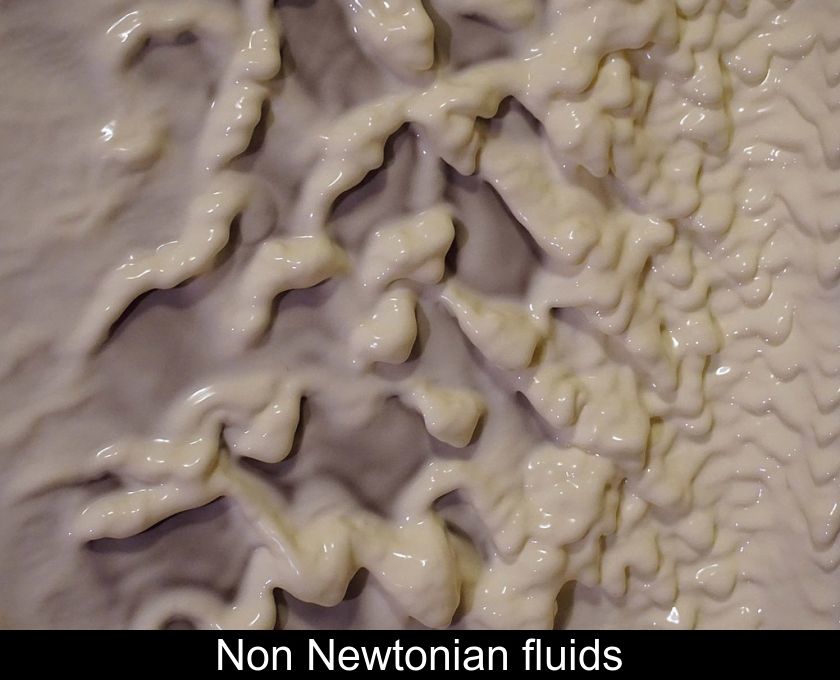Non Newtonian Fluids
Non-Newtonian fluids are substances with amazing physical and chemical properties. Under the appearance of fluids almost as liquid as water, this type of fluid has the particularity to become solid when a sufficiently strong pressure is exerted on it.
What is it about?
In chemistry, fluids are perfectly deformable media that can be gaseous (compressible fluids), liquid (low-compressible fluids), or neither (under certain temperature and pressure conditions).
The fluid mechanics is the branch of physics that studies the behavior of fluids when subjected to forces or stresses.
There are two main families of fluids based on their viscosity: so-called 'Newtonian' fluids and 'non-Newtonian' fluids.
The different types of fluids
Newtonian' fluids, such as water, air and most gases, have a constant viscosity or one that can only vary with temperature.
On the other hand, 'non-Newtonian' fluids have the particularity of having a variable viscosity, depending on the velocity and stresses they undergo.
In other words, the deformation of this type of fluid is not directly proportional to the force applied to it.
Examples of non-Newtonian fluids
The wet sand found in Seashore is a good example of the peculiarity of non-Newtonian fluids.
Indeed, if you hit wet sand, it has the consistency of a solid, whereas if you press on it gently, it behaves like a paste.
A safe little experiment to do at home is to mix water and cornstarch (cornstarch).
By slowly incorporating 2 scoops of starch into 1 scoop of water, you will in effect get a paste whose viscosity changes with the rate of stress applied.
The resulting mixture will behave like a solid if a spoon is pressed briskly into the surface, but like a liquid if the spoon is inserted slowly.
The video below shows that a person moving quickly or with sufficient force on the surface of a non-Newtonian liquid can literally Walk on such a liquid.
Research and applications of Newtonian fluids
Non-Newtonian fluids are the subject of extensive fundamental research, not only because they are so prevalent in nature, but also for potential applications such as making ballistic vests.
They are an interesting material because of their ability to absorb the impact of a projectile at high velocity, while remaining flexible enough to be worn without discomfort.
The branch of physics that studies them is called 'rheology'.
Summary on a non-Newtonian liquid
A fluid that deviates from Newton's law of viscosity - constant viscosity regardless of stress - is called non-Newtonian. When subjected to a force, the viscosity of non-Newtonian fluids can change, becoming either more liquid or more solid. For example, ketchup is a non-Newtonian fluid because when shaken, it becomes more liquid. Many salt solutions, molten polymers, custard,[1] toothpaste, starch suspensions, cornstarch, paint, blood, melted butter, and shampoo are examples of non-Newtonian fluids.
Most often, the viscosity of non-Newtonian fluids depends on the shear rate or shear rate history (the progressive deformation caused by shear or tensile stresses). Nevertheless, some non-Newtonian fluids whose viscosity is independent of shear rate continue to exhibit typical patterns of stress difference or other non-Newtonian behavior. In a Newtonian fluid, the viscosity coefficient serves as a constant of proportionality, and the relationship between shear stress and shear rate is linear, passing through the origin. The relationship between shear stress and shear rate differs in a non-Newtonian fluid. One can even observe a time-dependent viscosity in the fluid. It is therefore impossible to determine a constant viscosity coefficient.
Although viscosity is frequently used in fluid mechanics to explain the shear characteristics of a fluid, non-Newtonian fluids cannot always be adequately described by this concept. They can be examined more effectively using a number of additional rheological properties that relate the stress and strain rate tensors in many flow situations, such as oscillatory shear or extensional flow, and are determined by various instruments or rheometers. The tensor-valued constitutive equations, which are frequently used in continuum mechanics research, provide a superior tool for understanding these properties.











